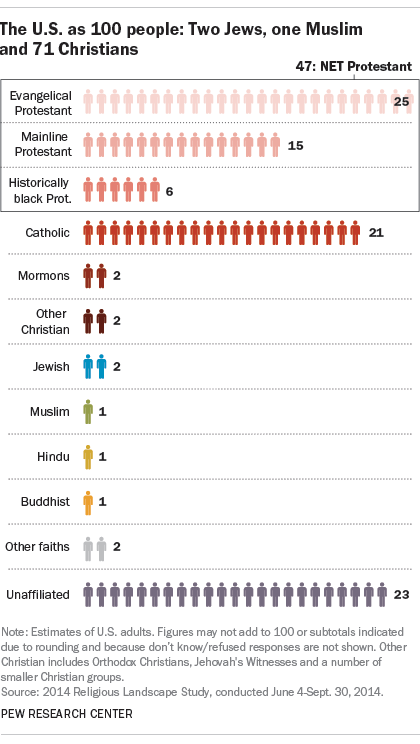Happy Holidays! Being Inclusive in Year-End Marketing Efforts

by Amberly Dressler
16 Jan, 2023
It is that time of the year again when holiday decorations and deals flood our screens and stores, and "Merry Christmas" is replaced (sometimes controversially) with more ambiguous seasonal greetings.
 As marketers, there is a fine line between exclusion and inclusion during year-end festivities. On one hand, the prominent spending event (and subsequent revenue) is centered on a Christian holiday. On the other, there is a significant percentage of Americans not associated with the faith. In 2016, Pew Research drew conclusions from past data of what the U.S. would look like if it contained just 100 adults (see image). In short, while most of this group would be of Christian faith, roughly a third would not be. Can brands afford to exclude a third of their American consumers?
As marketers, there is a fine line between exclusion and inclusion during year-end festivities. On one hand, the prominent spending event (and subsequent revenue) is centered on a Christian holiday. On the other, there is a significant percentage of Americans not associated with the faith. In 2016, Pew Research drew conclusions from past data of what the U.S. would look like if it contained just 100 adults (see image). In short, while most of this group would be of Christian faith, roughly a third would not be. Can brands afford to exclude a third of their American consumers?
From a business perspective it makes sense to spread Christmas cheer in promotions and on Web pages because of revenue-earning potential and the realization that the majority of customers are likely celebrating this holiday even for non-religious reasons. In fact, more than one in four (27 percent) Americans celebrating Christmas say their celebration of the holiday is not too religious according to a 2016 poll from Public Religion Research Institute. From an inclusion standpoint, companies are still wise to be culturally sensitive to non-Christians. What should be clear is there is no right answer to inclusion during the holidays, but there are ways to get everyone involved to improve inclusion organically.
Starbucks went through a 2015 "red cup" controversy when it removed "symbols of the season" used in the past (e.g., reindeer and ornaments) in favor of a two-toned red cup (CNN, 2015). The decision resulted in intense social media backlash from patrons believing the coffee company was "waging a war" on Christmas. The following year, Starbucks instead launched a user-generated content (UGC) initiative to feature multiple designs created by customers (see image). As a result, Starbucks changed the conversation via its customers.

"We hope that this year's red holiday cup designs express the shared spirit of the holidays as told by our customers," said Sharon Rothstein, Starbucks global chief marketing officer in a 2016 statement.
Once the cups hit their stores, Starbucks then invited customers to share photos of their red cups on social media. Today, there are more than 32,000 Instagram posts using #starbucksredcup. Not only does user-generated content (including permission-based photo curation) help include a wide variety of people and traditions, but it also shifts who is telling the story to make the narrative more relatable.
Marketers may have opinions about the use of Christmas verbiage in marketing messages - and opt for "Happy Holidays" - or they may want to include every "symbol of the season" in marketing collateral. The takeaway for seasonal inclusion might be, however, reducing the role a marketer's opinion play in some holiday marketing (particularly words and visuals).
By opening up holiday marketing messaging to consumers through a UGC contest or curation initiative (there is still time), companies will be able to share more stories and traditions than what could have been limited to a marketing team's own seasonal preferences. Kid clothing retailer Carter's, for example, launched a UGC contest last fall asking parents to tag Carter's in pictures of their "sleepyheads" for a chance to win a gift card. Over 3,700 photos were tagged #dreamlandsweepstakes on Instagram. Carter's obtained permission to use the photos and, most importantly, the efforts resulted in more relatable campaigns. The pictures were adorable and diverse.
Marketers looking to be more inclusive this winter should identify their own biases and empower customers (and even colleagues) to share their holiday stories and traditions versus being one voice in a very dynamic discussion.
 As marketers, there is a fine line between exclusion and inclusion during year-end festivities. On one hand, the prominent spending event (and subsequent revenue) is centered on a Christian holiday. On the other, there is a significant percentage of Americans not associated with the faith. In 2016, Pew Research drew conclusions from past data of what the U.S. would look like if it contained just 100 adults (see image). In short, while most of this group would be of Christian faith, roughly a third would not be. Can brands afford to exclude a third of their American consumers?
As marketers, there is a fine line between exclusion and inclusion during year-end festivities. On one hand, the prominent spending event (and subsequent revenue) is centered on a Christian holiday. On the other, there is a significant percentage of Americans not associated with the faith. In 2016, Pew Research drew conclusions from past data of what the U.S. would look like if it contained just 100 adults (see image). In short, while most of this group would be of Christian faith, roughly a third would not be. Can brands afford to exclude a third of their American consumers?
From a business perspective it makes sense to spread Christmas cheer in promotions and on Web pages because of revenue-earning potential and the realization that the majority of customers are likely celebrating this holiday even for non-religious reasons. In fact, more than one in four (27 percent) Americans celebrating Christmas say their celebration of the holiday is not too religious according to a 2016 poll from Public Religion Research Institute. From an inclusion standpoint, companies are still wise to be culturally sensitive to non-Christians. What should be clear is there is no right answer to inclusion during the holidays, but there are ways to get everyone involved to improve inclusion organically.
Starbucks went through a 2015 "red cup" controversy when it removed "symbols of the season" used in the past (e.g., reindeer and ornaments) in favor of a two-toned red cup (CNN, 2015). The decision resulted in intense social media backlash from patrons believing the coffee company was "waging a war" on Christmas. The following year, Starbucks instead launched a user-generated content (UGC) initiative to feature multiple designs created by customers (see image). As a result, Starbucks changed the conversation via its customers.

"We hope that this year's red holiday cup designs express the shared spirit of the holidays as told by our customers," said Sharon Rothstein, Starbucks global chief marketing officer in a 2016 statement.
Once the cups hit their stores, Starbucks then invited customers to share photos of their red cups on social media. Today, there are more than 32,000 Instagram posts using #starbucksredcup. Not only does user-generated content (including permission-based photo curation) help include a wide variety of people and traditions, but it also shifts who is telling the story to make the narrative more relatable.
Marketers may have opinions about the use of Christmas verbiage in marketing messages - and opt for "Happy Holidays" - or they may want to include every "symbol of the season" in marketing collateral. The takeaway for seasonal inclusion might be, however, reducing the role a marketer's opinion play in some holiday marketing (particularly words and visuals).
By opening up holiday marketing messaging to consumers through a UGC contest or curation initiative (there is still time), companies will be able to share more stories and traditions than what could have been limited to a marketing team's own seasonal preferences. Kid clothing retailer Carter's, for example, launched a UGC contest last fall asking parents to tag Carter's in pictures of their "sleepyheads" for a chance to win a gift card. Over 3,700 photos were tagged #dreamlandsweepstakes on Instagram. Carter's obtained permission to use the photos and, most importantly, the efforts resulted in more relatable campaigns. The pictures were adorable and diverse.
Marketers looking to be more inclusive this winter should identify their own biases and empower customers (and even colleagues) to share their holiday stories and traditions versus being one voice in a very dynamic discussion.

Amberly Dressler
Head of analyst relations, public relations, customer advocacy (People Heroes), customer community, content marketing (full funnel/lifecycle), content operations and optimization, reputation management and social media. Leads a team of nine superstars to exceed our goals multi-fold.






